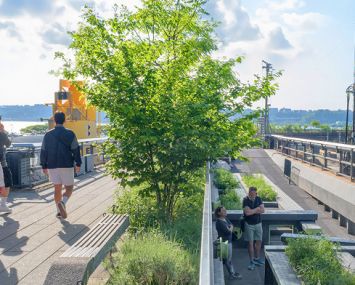Each tenant has its own unique office space requirements, but some—social media and tech firms, for instance—share similar architectural “wish lists.”
For brokers, these common threads offer insight into how to help tenants hone in on the ideal space faster. For landlords and building owners, they provide valuable direction on how to attract the right kind of end-users.
So what’s our top request? Without a doubt, social media and tech firms want a “beyond hipster” location. These are the next big thing, the neighborhoods that all the hip and savvy growth-stage companies want to be in: Midtown South, Soho, the West Village, Dumbo and cities along the New Jersey waterfront, to name a few.
Firms are migrating to the outer edges of these already-established neighborhoods to get the vibe they covet at a friendlier rental rate, and, as a result, neighborhood boundaries are being redefined and pushed outward.
Once a social media or tech firm zeroes in on a neighborhood, the next concern is making sure it has, or we can create for them, the amenities their work force desires. Social media and tech firms typically attract younger employees who work outside the conventional “nine to five” and blend their personal and professional lives more closely.
For them, the office is part of their community. As such, brokers should pay keen attention to the building and neighborhood amenities. Is there a burger joint downstairs? A fitness center? Hip restaurants that cater to this demographic? Ultimately, the tenants can dictate if they want to create those “community attractions” within their space or if the neighborhood brings those pieces in seamlessly (if so, that full-service seating area becomes an option, rather than a requirement). It simply depends on the deal.
Social media and tech firms are also requesting office space with a residential feel to evoke a sense of “home away from home.” That doesn’t mean using mom’s couch in the lobby, though. Tenants are seeking out a cooler kind of comfort, customized for a personal experience. These touches bring warmth to the work environment and put all the pieces together under the same choreographed framework.
Daylight is also a primary concern. Whether it comes from oversize windows, skylights or high, open exposed ceilings, there are many options for making the most of natural light while adhering to a tenant’s budget. While there is a sustainable benefit to doing so, most social media and tech firms see that as an extra, rather than the primary reason to utilize daylight. Mainly, they want to enhance the appeal of the space and make it a happier, more productive place to work.
Extra attention to acoustics is a must for social media and tech tenants. Most of these firms prefer wide-open spaces with hard surfaces, such as concrete, sheetrock, exposed brick and glass. While these materials are visually appealing, they pose challenges as firms grow and mature and become one of the most important factors in the decision to expand or move down the road. Stylish acoustically sensitive drop ceilings can add a functional, style-savvy element to a space, or the tenant can work with an acoustic professional to introduce white noise. The solutions extend way beyond “plain vanilla” suspended ceilings!
One of my personal favorite trends among social media and tech tenants these days is seeing internal stairs as more than just a basic mode of vertical transportation. For tenants with multiple floors and a need to commune, enlarged staircases become an architectural focal point and serve a practical purpose, subbing in as tiered stadium-style seating and a place to gather, interact, sit and share ideas. Best of all, they can be easily incorporated into the overall design and add great value.
Speaking of value, social media and tech firms prefer to maximize space, which is why that demographic is requesting the greatest density per square foot possible. The present average among these users is 140 to 160 rentable square feet per person (less than we’ve ever seen before), as opposed to the 225 to 275 per person typically found among hedge funds and private equity firms. It is certainly possible to meet these requirements, but not without additional work in creating open floor plans and collaborative spaces or, as we’ve recently learned from a client, “collision areas” to fit the logistic requirements and keep the vision of the space alive.
Last, but certainly not least, a social media or tech firm’s offices need to be wired for spontaneous creativity areas. These could be as simple as “huddle zones” with mobile white boards and a few comfortable chairs spread throughout the space. Collaborative nanotechnology areas are popular and need to be written into the design, with the necessary power and telecom to make it work, so workers can gather, laptops in hand, and interact on a moment’s notice.
So given this information, what’s a landlord or building owner to do? I’m glad you asked. Next week’s column will be all about this same topic—social media and tech firm trends—but will focus on how to respond to their needs so you can attract and retain these tenants.


